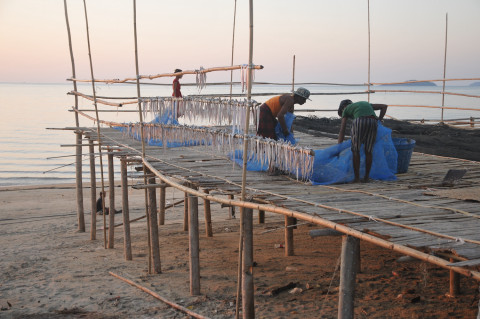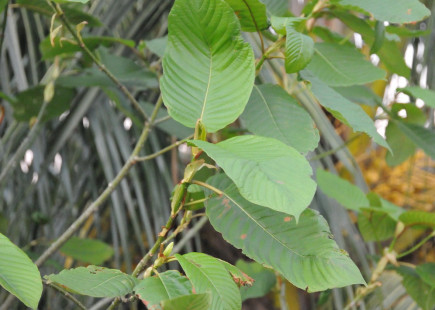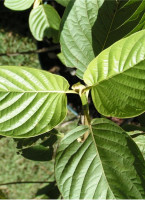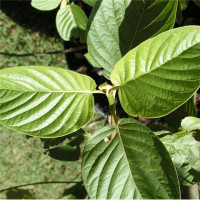Kratom in Myanmar and southeast Asia: time for legal regulation? A commentary by TNI
Commonly found in Southeast Asia including in Myanmar, leaves from the kratom tree have long been used as a traditional medicine to treat various health conditions, including diabetes, diarrhoea, fever and pain. Kratom is currently banned in Myanmar, and the WHO's Expert Committee on Drug Dependence (ECDD) is discussing this week whether it should be placed under international drug control. Instead of criminalisation, however, this commentary argues that legal regulation of kratom could contribute to building safer communities, promoting development and supporting peace efforts in Myanmar and beyond.

TNI
The multiple crises of coup, covid and conflict that conflated and struck Myanmar are currently the main focus of people’s attention, both domestically and abroad. These crises have affected every sector of society, bringing enormous suffering and misery to families and communities across the country.
Although it is understandably not a priority issue for people in Myanmar, an important international meeting on drug policy is taking place this week in Geneva, which could have far reaching repercussions for the country. Initiated on the 11th and planned to end on 15 October 2021, the Expert Committee on Drug Dependence (ECDD) of the World Health Organization (WHO) is conducting a pre-review of kratom. Kratom is a tree indigenous to Southeast Asia that has long been cultivated and consumed by communities in Mon State and Tanintharyi Region. The expert committee will examine the current state of evidence on the potential of kratom and two of its main chemical compounds - mitragynine and 7-hydroxymitragynine, to cause dependence, harms to the health of users, and to be used for therapeutic purposes. On this basis, it will decide whether a formal critical review is justified, a step that could ultimately - but not necessarily - lead to the placement of kratom under international control.
Kratom is currently not included among substances placed under international control, and has never been reviewed by WHO. While illegal in Myanmar under the 1993 Narcotic Drugs and Psychotropic Substances Law, Thailand has recently fully legalised the cultivation, use, trade and manufacturing of kratom. Kratom use is also prevalent in Malaysia, Indonesia, Papua New Guinea and the Philippines.
Kratom use and cultivation in Myanmar and Southeast Asia: a long, yet often ignored legacy
Kratom is the common name for Mitragyna Speciosa, a tropical tree belonging to the Rubiaceae family, which also includes coffee plants. Indigenous to Southeast Asia, kratom trees can grow up to 25 metres high, and are most commonly found in southern Thailand, Malaysia, Indonesia, Papua New Guinea, the Philippines and southern Myanmar. The tree’s characteristic large leaves contain numerous alkaloids, a scientific term used to describe organic compounds with specific pharmacological properties naturally present in certain plants. Mitragynine and 7-hydroxymitragynine, two of the main alkaloids contained in kratom, act on the central nervous system and can induce either stimulant or sedating effects, depending on dosage and individual reactions. Psychoactive effects caused by the plant, however, remain relatively mild, especially when kratom leaves are consumed in their natural form. To use an analogy easily understandable in the Myanmar context, the effects of kratom could be compared, in terms of their intensity, to that of betel nut. In fact, kratom leaves have been used for centuries by various indigenous populations living across Southeast Asia, including in some rural communities from Mon State and Tanintharyi Region. In Myanmar, kratom is known as ‘Bein Sa Ywek’, ‘Bai Lar’ and ‘Ahma Pharon’ in Burmese, Karen and Mon language respectively. The dry leaves are usually ground to powder and are either chewed or infused in tea-like preparations. Kratom has long been used as a traditional medicine to treat various health conditions, including diabetes, diarrhoea, fever and pain, as exemplified by a Karen elder from Tanintharyi Region:
“When I was a child, we had no western medicines in our village. When children got sick and had fever, our parents just went to the forest, picked some leaves from Kratom trees and boiled them. We felt better and recovered very quick after taking Kratom tea. We are still using Kratom tea nowadays to treat many illnesses, such as coughing, diarrhoea and diabetes.”
In Malaysia, kratom has also been used for decades by dependent heroin users to alleviate pain and physical discomfort caused by opiate withdrawal symptoms, thus supporting their efforts to cease their opiate use.1 Similarly, some young people from Mon State successfully transitioned from methamphetamine to kratom use, which they perceived as far less harmful and debilitating than ATS tablets.2 As expressed by a former ATS user in Mon State:
“I got the habit of using ATS while I was working as a factory worker in Thailand. I could afford buying the tablets (ATS) in Thailand as I had income. However, when I came back here doing family farming I had no regular income, so I swapped to using ‘mixed Kratom tea’. I think it is less dangerous than tablets (ATS), and I’m fit to work, eat and sleep well.”
Although more research is needed to confirm these findings, these promising experiences highlight the high potential of kratom to be used as a therapeutic substitute for dependent drug users. This is particularly so in Southeast Asia, in light of kratom’s local availability, cost-effectiveness and cultural suitability.
In addition to its various medicinal usages, kratom is also commonly used to combat fatigue and improve productivity at work, especially in agricultural and manual labour. In Tanintharyi Region, people working in rubber plantations and fishing boats often consume kratom leaves to relieve pain and to endure physically exhausting work in difficult climatic conditions, as captured by the words of a fisherman from a coastal village:
“I chew Kratom leaves while I am on a fishing trip. It makes me feel better to work under the sun and I can dive longer to fit the fishing net in the sea.”
Kratom is used for similar reasons by fishing communities living on the coast of Mon State. These consist mostly of Bamar migrants who work on bamboo fishing rafts anchored offshore, on which they can spend several days in a row fishing. According to an owner of several fishing rafts:
“This is a very hard job they do. I grow kratom plants in my compound to provide its leaves to my workers on the rafts. They drink it as a tea, to help them work longer hours and to build their resilience to extreme conditions on the raft. Sometimes they also chew the leaves. I mainly grow kratom for my workers, but sometimes I also take it. We do not see any negative consequences from using kratom.”
In remote Karen communities from the Myeik archipelago, in Tanintharyi Region, kratom use is considered as a valuable part of local traditions and customs, and is not regarded as “drug use” or a deviant practice. In fact, in these villages, chewing kratom leaves or powder and drinking kratom tea with friends are considered rather ordinary activities, performed on a nearly daily basis, just as drinking tea or chewing betel nut. As most users face no apparent difficulty in reconciling their use with professional, financial and family obligations, kratom is rarely associated with social impairment and stigma and poses no significant problem in these communities.

TNI
Notwithstanding its century-long history of use in the region, evidence of seriously problematic use has yet to emerge. While some negative consequences have naturally been documented, these are generally relatively mild and are mostly associated with intense and prolonged use. These notably include constipation, weight loss, insomnia, skin pigmentation, as well as lower sexual drive.3 In addition, some level of dependence is also known to occur, although here again, withdrawal symptoms such as joint pain, sweats and sleeplessness, tension, decreased appetite and watery eyes, have been described as relatively mild.4
Besides traditional usages, new forms of kratom use have also emerged in recent years, in particular among youths from urban areas. Cocktails involving a mix of kratom powder, cough syrup, yoghurt and coffee, commonly known as ‘Asean’, have become more popular in Myeik and certain towns in Mon State.5 Similar beverages are consumed in Thailand too, where cocktails composed of infused kratom leaves, coca cola, cough syrup and ice cubes are known as “4x100” (‘Sii khoon roi’).6 The principal risks of these cocktails, however, are likely due to the presence of pharmaceutical products such as cough syrups, or in some cases benzodiazepines, due to interactions which can amplify kratom’s effects. The addition of other unusual and potentially harmful adulterants, such as crushed mosquito coil and gas extracted from fluorescent bulbs, has also been occasionally reported in media. No consistent evidence, however, has emerged to support these sensationalist claims.
Globalisation of practices and the emergence of a ‘kratom threat’
In recent years, the United States (US) and a few European countries have expressed growing concern that kratom, while having no recognised therapeutic use, could pose a serious risk to public health and society. It is noteworthy that kratom use was introduced in these countries only relatively recently, and therefore lacks the cultural and social significance it has acquired in Southeast Asia. In the US and Europe, numerous kratom products are sold as processed food supplements, some of which contain high contents of isolated mitragynine and other alkaloids, in contrast with kratom leaves in their natural form as they are consumed in Myanmar and other Southeast Asian countries. A number of lethal overdoses and severe intoxications, presumably due to kratom, were reported during the past few years. Blood analysis and other medical investigations, however, revealed that in almost every instance, other psychoactive substances were involved in the overdoses, making it difficult to establish causality.7 Moreover, claims that kratom has no recognised therapeutic value are considerably at odds with the long and documented history of medicinal use in Southeast Asia. In reality, such assertions reveal deeply entrenched ethnocentrism and biased assumptions, and ignore a growing body of evidence that shows the potential of kratom to be safely and effectively used to relieve opioid dependence.8
As previously mentioned, kratom is currently not included among substances that are placed under international control. UN member states, as a result, are not compelled to control or criminalise its cultivation, use, possession, production, distribution and trading. Some countries have nevertheless decided to do so, while others have chosen to allow kratom to be freely grown, consumed and sold. In practice, the legal status of kratom can vary significantly from place to place. Kratom is for instance legally regulated in several US States, although a few have also decided to ban it. Kratom remains fully illegal in Australia, where it is placed on the most restrictive level of the Australian National Drugs and Poisons Schedule, but can be legally sold and consumed in New Zealand upon presentation of a medical prescription. In Southeast Asia, the region where it originates, kratom remains illegal in Singapore, Vietnam and Malaysia, but also in Myanmar. In fact, the 1993 Narcotic Drugs and Psychotropic Substances Law prescribes that the cultivation, possession, distribution and transportation of kratom are criminal offences punishable with long-term prison penalties. Although kratom is usually not considered as a priority target by law enforcement agencies, a number of arrests and eradication campaigns have been reported in the country in recent years, notably in Tanintharyi region.9 In the absence of serious harms to the health of users and society at large, the criminalisation of kratom seems unnecessary and even counter-productive. First, repression has done little to curb the availability and use of kratom, which remains common in the country’s south, and has not prevented the emergence of new practices among youths, such as the consumption of ‘Asean’ cocktails. Second, criminalising kratom requires the mobilisation of significant human and financial resources in the form of law enforcement operations and personnel, judiciary procedures and detention facilities. In addition, continued focus on repression has directly contributed to prison overcrowding. Finally, enforcing kratom bans in areas where it has long been used for traditional and medicinal purposes is a violation of indigenous cultural rights and heritage.
In stark contrast, Thailand recently decided to decriminalise kratom and took steps to establish a legally regulated market. This is a promising development, considering the country’s decades-long prohibition of the tree. In fact, Thailand was the first country in the region to introduce a national ban on kratom, as early as 1943. Revenues collected by the State on opium, legal at that time under a State monopoly, started to decline when a growing number of users switched from opium to kratom use, due to increasing opium costs. The Kratom Act was then introduced as an attempt to stem that movement and suppress competition in the opium market. The ban, however, remained only loosely enforced, including after kratom was rescheduled to category V, the least restrictive category, in 1979. This changed significantly at the turn of the century, when the Prime Minister Thaksin Shinawatra launched a war on drugs that resulted in thousands of extra judiciary killings.10 Repression became especially stringent in the country’s south, where kratom use and cultivation had long been prevalent, especially among the ethnic Malay Muslim population. Kratom law enforcement was used to justify military operations against Muslim communities, who were seen as supporting the armed insurgency in the area. Thousands of kratom related arrests followed over the next fifteen years, fuelling high tension and resentment among local communities.11 In a dramatic turn of events, Thailand decided to break with this heritage of repression, and in 2019 allowed kratom – as well as cannabis - use for medical purposes. Kratom cultivation, possession and use were also decriminalised in southern provinces under an innovative community control model. Two years later, kratom was finally removed from the Narcotic Drugs Act and Thailand became the first Southeast Asian country to fully, legally regulate kratom cultivation, use, trade and manufacturing.12 A similar evolution might take place in Indonesia, despite the country’s National Narcotics Board’s push to put kratom in the strictest Schedule I in the narcotics law – a move criticised by local authorities in Borneo, from which kratom is exported. In 2019, the Ministry of Health conducted a study that highlighted kratom’s valuable botanical and chemical properties and its significance as a source of livelihood and traditional or indigenous medicine, as well as its ecological importance and its potential in supporting sustainable development.13
Rehabilitating kratom cultural heritage through decriminalisation and legal regulation in Myanmar?
As the WHO’s Expert Committee on Drug Dependence holds its pre-review meeting on kratom, an honest assessment of current policies is urgently needed. Rather than continuing on the path of prohibition and criminalisation, Myanmar and other Southeast Asian nations have a unique opportunity to embrace and experiment an alternative approach based on the recognition of the region’s traditions and cultural heritage. Myanmar has had a long history of mostly unproblematic kratom use and cultivation. Authorising and regulating kratom production, trade and use, would provide multiple and immediate benefits to both authorities and communities: health programmes and interventions, including pilot kratom substitution programmes, could be introduced and implemented; rigorous quality control and distribution mechanisms could be set; new and legal livelihood opportunities could be created in areas where kratom trees can be grown. Moreover, the decriminalisation of kratom would relieve pressure on the criminal justice system and end a legacy of human rights abuses and violations.
The recent international developments linked to cannabis reform can provide valuable insights and lessons to learn from, in particular to ensure that commercial interests do not ultimately prevail over public health and social justice objectives. Keeping this mind, it is especially important that local regulation and enforcement mechanisms are defined in close collaboration and with the meaningful involvement of affected communities.
Drug policies, all around the world, have for too long fuelled conflict and division. The vicious cycle of repression can no longer be ignored. More than ever, it is time for local communities and all relevant actors to find new ways to address drug-related issues in the country. This should start with the recognition that the decriminalisation and legal regulation of kratom have an important role to play in building safer and more resilient communities, promoting development and supporting peace efforts in Myanmar and beyond.
Endnotes
1. Balasingam Vicknasingama, Suresh Narayananb, Goh Teik Benga, and Sharif Mahsufi Mansora, ‘The informal use of ketum (Mitragyna speciosa) for opioid withdrawal in the northern states of peninsular Malaysia and implications for drug substitution therapy’, published in International Journal of Drug Policy 21 (2010) 283–288;
2. Assessment conducted in Mon State in 2020 by Mon Area Community Development Organization (MACDO), upcoming report;
3. Singh D, Narayanan S, Vicknasingam B, ‘Traditional and nontraditional uses of Mitragynine (Kratom): a survey of the literature’, Brain Res Bull. 2016;126(Pt 1):41–46. doi:10.1016/j.brainresbull.2016.05.004
4. Singh D, Muller CP, Vicknasingam BK, ‘Kratom (Mitragyna speciosa) dependence, withdrawal symptoms and craving in regular users’, Drug Alcohol Depend. 2014;139:132–137. doi:10.1016/j.drugalcdep.2014.03.017
5. Thura Myint Lwin and Renaud Cachia, ‘Methamphetamine use in Myanmar, Thailand, and Southern China: assessing practices, reducing harms’, TNI https://www.tni.org/en/ats-harmreduction
6. Pascal Tanguay, ‘Kratom in Thailand: Decriminalization and Community Control?’, TNI and IDPC https://www.tni.org/en/briefing/kratom-thailand-decriminalisation-and-c…
7. UNODC, Current NPS Threats, Volume II, January 2020, p. 2. https://www.unodc.org/documents/scientific/Current_NPS_Threats_Volume_I…
8. See: https://ufhealth.org/news/2020/kratom-tea-study-stirs-new-support-relie… https://www.sciencedirect.com/science/article/abs/pii/S0376871619301966
9. UNODC, Patterns and Trends of Amphetamine-Type Stimulants (ATS) and Other Drugs of Abuse in East Asia and the Pacific 2006, A Report from Project: TDRASF97 Improving ATS Data and Information Systems, June 2007, p. 121.
UNODC, The Challenge of Synthetic Drugs in East and South-East Asia and Oceania, Trends and Patterns of Amphetamine-type Stimulants and New Psychoactive Substances, A Report from the Global SMART Programme, May 2015, p. 30.
10. See: https://www.hrw.org/news/2008/03/12/thailands-war-drugs
11. Pascal Tanguay, ‘Kratom in Thailand: Decriminalization and Community Control?’, TNI and IDPC https://www.tni.org/en/briefing/kratom-thailand-decriminalisation-and-c…
12. Kratom production needs FDA approval, Bangkok Post, 4 September 2021. https://www.bangkokpost.com/thailand/general/2175551/kratom-production-…
13. Wahyono, S, et al., Kratom: Prospek Kesehatan dan Sosial Ekonomi, Lembaga Penerbit Badan Penelitian dan Pengembangan Kesehatan, Kementerian Kesehatan Republik Indonesia, 2019.

